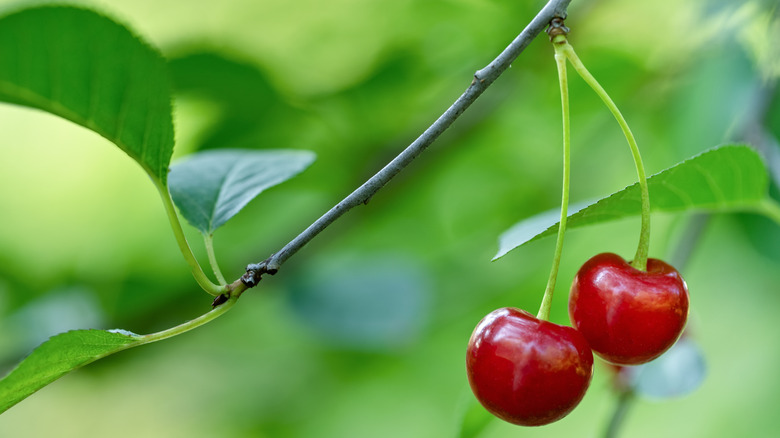Want To Grow Your Own Fruit But Have Limited Space? A Fruit Salad Tree Might Be The Answer
We'd all love an orchard with unlimited fruit trees, a cornucopia of variety that goes on for acres. But a massive fruit orchard isn't in the cards for many home gardeners. Most of us are lucky if we can get a tree or two planted on the edges of the vegetable patch — and that means we're limited on what kinds of fruit we can grow. The choice must be made between an apricot tree or a nectarine, oranges or lemons, one of the many varieties of green apples or the red ones...right? While that was the case in the past, you aren't restricted to just one kind of fruit per tree anymore. Now we have fruit salad trees – they'll produce up to eight different kinds of fruit on a single tree.
The caveat is that the fruit has to be related. You couldn't combine a peach with an apple, for example, but you can grow a stone fruit salad tree that produces peaches, nectarines, apricots, plums, cherries, and almonds. And it can produce all of those fruits at the same time, so you could literally put together a beautiful, nutty, stone fruit salad with tons of variety from just one tree. Or, grow the perfect variety of apples for specific baked goods on a single tree and make it easy to harvest fruit for pies, apple crisp, and so on.
How does a fruit salad tree even exist?
A fruit salad tree sounds too whimsical to be true, but all it takes is a little grafting to turn a regular fruit tree into something out of a dream. Luckily, grafting is the backbone of the fruit tree business, anyway, so there's no shortage of training available if you want to learn how to build your own fruit salad tree. Arborists use grafting to propagate most fruit trees to control genetics and grow trees that have certain traits. They also graft because fruit tree seeds are unpredictable. When you grow an apple tree from seed, the only thing you can guarantee is the fruit of that tree won't be the same as the parent fruit. Grafting allows arborists to continue growing the same fruit varieties over generations.
Grafting is when you take a cutting of one kind of tree and fuse it with another kind of tree. Usually, arborists cut a slit into the rootstock of a certain kind of tree and insert the cutting. Then the whole thing is wrapped. As it grows, the slit in the rootstock heals and the cutting becomes part of the tree. In the case of a fruit salad tree, as the rootstock grows, all of the cuttings grow with it, and you get a magical mix of fruit-bearing branches all on one tree.
How to go about planting your own fruit salad tree
Your first two decisions are where you're going to plant a fruit salad tree and how you're going to get it. These trees will fruit in surprisingly small spaces – you could grow one in a large pot on your front porch. They're bigger when planted in the ground, though, where they will typically grow to around 5 to 15 feet in height depending on factors like rootstock type and growing conditions. Your tree will need 6-8 hours of full sun and well-draining soil, and be sure to choose fruit varieties that are compatible with your growing zone.
Once you've chosen the location for your tree, decide whether you're grafting your own or buying one already grafted from a tree nursery. Four-variety fruit salad trees are very common, and you can order them online from quite a few nurseries starting at around $50. The more fruit types you add, the higher the price tag will climb, and you'll have to hunt for a tree that has more than five fruits in one. If you have your heart set on a tree with more fruit choices than that, you might have to graft it yourself.
While your young tree grows, you'll want to check that each of your grafts is growing at roughly the same rate. A graft that seems to be shooting up faster than the others can ultimately lead to an unbalanced fruit salad tree, as the "winner" absorbs most of the nutrients, stifling the other fruit grafts. If this happens, prune back the graft that is trying to dominate. This will ensure you actually have a nice fruit salad tree growing on your property rather than a single-fruit tree.


